What is the 'methodology for the weak to beat the strong in war' that can be learned from history?

In the war between Ukraine and Russia, it is said that the Ukrainian side is inferior in strength. If you look around history, you'll find a number of examples of the vulnerable side winning in such a war with different strengths, but tell us what the success pattern is when the vulnerable side wins at North Carolina State University's School of History. Brett Devero explains.
Collections: How the Weak Can Win – A Primer on Protracted War – A Collection of Unmitigated Pedantry
·table of contents
◆ 1: In the case of the Chinese Civil War
◆ 2: In the case of the Vietnam War
◆ 3: In the case of the Afghanistan conflict
◆ 4: What will happen to Russia's invasion of Ukraine?
◆ 1: In the case of the Chinese Civil War
Mr. Devero first takes the Chinese Communist Party as an example. The Red Army was organized as an army of the Communist Party in 1927 and laid the foundation of power in Jiangxi Province in southeastern China in the early 1930s. However, it was forced to withdraw by the National Revolutionary Army led by Chiang Kai-shek in 1934, and moved to Shaanxi Province in 1936 after a ' long march ' that traveled over 12,500 km on foot.
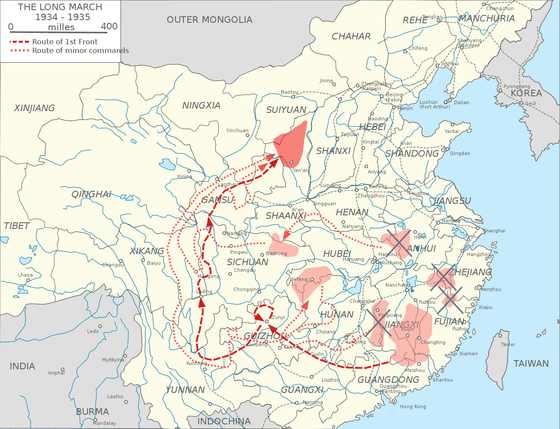
By
It is clear that Chiang Kai-shek's National Revolutionary Army is stronger, and what is worse, the Sino-Japanese War began in 1937, and the Japanese army defeated the National Revolutionary Army. Therefore, Mao Zedong's Communist Party had to defeat two stronger troops to win China. And the Communist Party did not have the industrial capacity to produce weapons, as well as the weapons needed for the war.
Therefore, the Red Army could not choose the 'quick decisive battle' victory method of overthrowing the enemy army, occupying the territory, and preventing the enemy from developing a new army. Mao Zedong stated in his ' (PDF) On Protracted War' that the path to victory lies in the endurance war that prolongs the war as much as possible, and for that purpose, it is necessary to proceed with the war by using the following three methods for each phase. It states that there is.
1: Base battle
Base warfare is a traditional method of war that seeks to continue occupying the territory, with regular units of the Red Army conducting base warfare.
2: Mobile warfare
The athletic battle is to quickly attack and retreat to the side of the advancing enemy unit. Mobile warfare is also conducted by the regular units of the Red Army.
3: Guerrilla warfare
Guerrilla warfare involves sabotage, assassination, and raids by irregular troops within the enemy's territory.
In the first phase, the Red Army will retreat and engage in mobile warfare instead, as a position battle against an enemy's strategic attack will only result in a defeat. Doing so will give you time to weaken your enemies instead of losing land. And, only after the enemy has moved a long distance and the supply line has been extended and weakened, the battle will be held in a place where the terrain is advantageous, such as a mountain base. It is also important to leave guerrilla units in the enemy's occupied territories as the enemy advances.
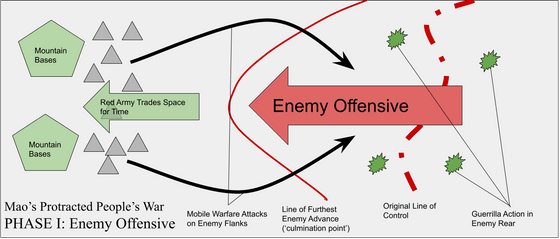
If you continue to withdraw, the enemy will be short of breath due to
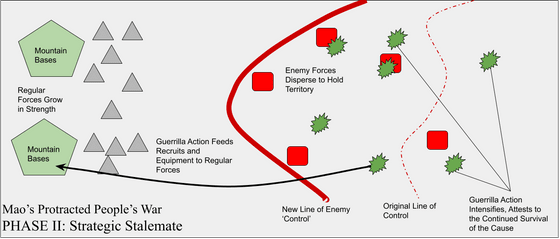
In the third phase, after weakening the enemy with a guerrilla attack and strengthening the Red Army with stolen goods and recruits, we will regain the position battle and recapture the lost territory.
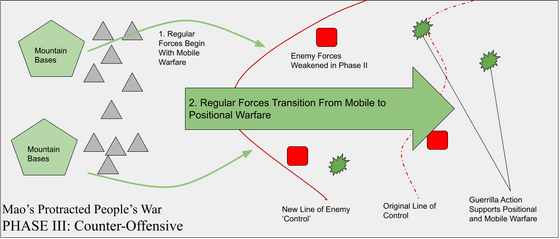
In this series of events, Mao Zedong emphasizes the importance of political activity. For guerrilla success, it is important that people do not report on guerrillas for whatever reason. When the Red Army retreats in the first phase, it is necessary to prepare politically in the area where it retreats, and after the retreat, the guerrillas need to carry out political activities. Guerrilla political activity is important not only to help conceal the existence of guerrillas, but also to give hope that the withdrawal of the Red Army is temporary and that there is a way to a final victory.
Throughout the whole, it can be said that we found a win by focusing on ' will ' rather than 'firepower' confrontation war. By gradually increasing the number of casualties and small defeats of the enemy in the second phase, the will of the enemy is reduced and it leads to victory in the third phase.
Mao Zedong is open to the point that prolonging the war can cause a lot of suffering for people. In particular, there are many casualties in the guerrilla army, and guerrilla activities are more likely to cause occupiers to implement oppressive policies. Mao Zedong wasn't very interested in these damages, but it's important to note that endurance warfare is a strategy that creates a lot of collateral damage.
Mao Zedong devised such a strategy, but in actual history, most of the Sino-Japanese War remained in the battle between the National Party army led by Chiang Kai-shek and the Japanese army, and the power of the Japanese army due to the bombing by the US army and the threat of the submarine. The Japanese army remained in a strong position even in the final phase of the weakening, and eventually the United States, not China, drove the Japanese army to defeat. However, the National Revolutionary Army was fatally weakened through the Sino-Japanese War, and with the support of the Soviet Union, Mao Zedong immediately moved to the third phase, skipping much of the theory and winning.
◆ 2: In the case of the Vietnam War
Devero's blog mentions the Vietnam War as another case. The Vietnam War was a confrontation between the South Vietnamese army supported by the United States and the North Vietnamese army led by Vo Nguyen Giap, and South Vietnam advanced toward the north.

By SnowFire
In the case of the Vietnam War, Mao Zedong's on protracted war cannot be applied as it is. Mao Zedong expected to beat the National Revolutionary Army over time, but there was a big difference between the fighting power of the US Army and the fighting power of the North Vietnamese Army, and there was no chance of winning. Furthermore, even if you try to withdraw and save time, Vietnam has only about 4% of the land of China, and most of the land is within 300 km from the coastline, so it seems that you will be in a place like Mao Zedong where enemy troops can not reach. That was impossible.
Therefore, although the theory needs to be adjusted, the basic part of the theory, 'prolong the war as much as possible, focus on the will rather than the firepower, and proceed slowly and step by step' remains the same. On top of that, Zap put more emphasis on political activity and integrated it with military operations as part of its strategy. Zap's political activities were broadly divided into three parties.
1: Own citizen
Political activity against its own people was propaganda, with the purpose of strengthening the will of the masses to support the war and recruiting recruits.
2: Enemy people
For Vietnamese who lived in the occupied territories of South Vietnam and had not yet participated in the fighting, they converted to the Communist Party and engaged in propaganda and violence to create conflicts.
3: Enemy army
The act of terrorism demoralized the enemy army and tried to stop the Vietnamese from supporting the enemy.
It is stated that one of the reasons why political activity was so important in Zap's strategy was that Zap knew that the guerrilla army casualties were very poor. It was so inferior in terms of equipment that large-scale drafting was essential to compensate for the loss of soldiers.
The first phase relied on guerrilla and political activity in the enemy-occupied areas, as the North Vietnamese troops had no area to retreat. The figure below shows the guerrilla activities from 1957 to 1960. The red dots represent the rebels and the flame marks represent the acts of terrorism.
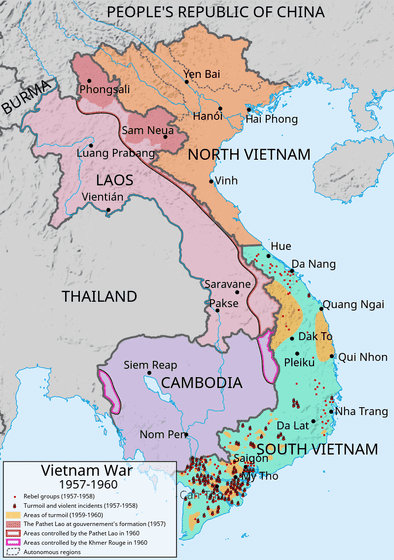
By
The North Vietnamese army was implementing a strategy based on this on protracted war theory, but Mao Zedong was the exclusive leader in the Chinese Communist Party, while in North Vietnam several people such as Le Duan I was planning a strategy. Le Duan advocated a more general strategy, winning regular battles in the Battle of Binjan in December 1964 and the Battle of Don Soai in June 1965. However, it is said that this battle caused the United States to intervene in the war entirely.
Le Duan used the same strategy in the 1968 Tet Offensive , exposing the North Vietnamese army to enemy war and defeating it. Although the Tet Offensive succeeded in making American public opinion anti-war by temporarily gaining an advantage, the North Vietnamese troops who lost the battle were forced to return to the previous guerrilla warfare phase.
Zap's framework allows you to recover from a failure by flexibly changing phases, such as returning to the second or first phase in response to a failure to move to the third phase. But, of course, this endurance strategy does not always lead to victory, and just as Che Guevara failed, governments facing rebels justify the use of force based on guerrilla terrorist acts. Is possible.
◆ 3: In the case of the Afghanistan conflict
Looking at another successful case, the Taliban settled in the Hindu Kush Mountains on the border between Afghanistan and Pakistan, deployed Zap-like propaganda, and demanded help from people through terrorist acts and assassinations. The use of modern media such as SNS for propaganda by the Taliban and ISIS is a major technical adaptation of the theory. The figure below shows the power map as of August 2021, where the Afghan government's territory is painted red and the Taliban's territory is painted white.
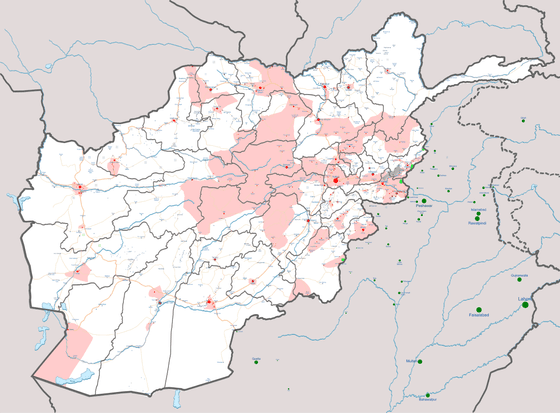
By Ali Zifan
Like the North Vietnamese army, the Taliban could not attack the continental United States, so the 'will' of the United States was the target of the attack. The Taliban are willing to inflict so many casualties and accept to make the war a protracted endurance war, starting the third phase after the U.S. military has left and taking territory from the weakened Afghan government. I took it away.
What we see in all these examples is that external support is important. In particular, the provision of weapons and safe bases plays a vital role in the success of endurance warfare. As Mao Zedong wrote, it is possible to steal equipment from the enemy, but having a foreign sponsor who can provide the equipment is even more effective.
Based on the above example, Devero summarizes the basic characteristics common to endurance strategy. First of all, if you can win the fast decisive battle, you should do the fast decisive battle. Endurance battles can be very damaging, so if you can win the fast decisive battle, it's best to take advantage of it. Endurance is a strategy for the weak.
The goal of endurance is to move the center of gravity of the war from military power to 'will.' The longer the war, the more opportunities there are to reduce the will of the enemy and increase the number of friendly people.
Also, since it is impossible for the weak to aim for victory directly from the beginning, the war is divided into several phases and progresses in stages. In the first phase, assuming that the strong will try to make a quick battle, the weak must avoid the enemy's excellent firepower by surrendering the land to gain time and with the cooperation of the people. .. The goal of this phase is to prevent the attackers from advancing to prolong the war.
If the first phase is successful, the front will be stuck, giving the weak time to keep the enemy's will down. During this period, we will increase the fighting power of our army by recruiting recruits and relying on the outside. When the enemy's will is sufficiently weakened and foreign partners withdraw, it is possible for the originally weak side to engage in traditional position battles and win.
◆ 4: What will happen to Russia's invasion of Ukraine?
As mentioned above, the patterns common to various types of endurance warfare are 'prolongation,' 'focus on will,' 'political efforts are important alongside military efforts,' and 'progress in stages.' Devero said he wrote an article about endurance because the methodology of endurance is related to how Ukraine knows how to win, or at least prevents the Russian army from achieving its goals. I am saying. Ukraine is in a situation similar to the successful endurance war.
Therefore, in Devero's view, Ukraine needs to prolong the war as long as possible in order to win, and it must be more motivated to win than Russia. Russia is made up of Vladimir Putin, Putin's main supporters, and frontline soldiers, who could end their hostilities if they could break one's will. In this war, Ukraine needs to focus on 'will' and increase the will of Ukraine while lowering the will of Russia.
The situation in Ukraine is also different from the three cases of endurance warfare. Since Ukraine is a nation, it can produce modern industrialized forces. Different international conditions have different terrains. Ukraine is mostly flat and open land, separated by one large river and several small rivers. With few topographical obstacles, the Russian army cannot be stopped for a long time, and it is impossible to retreat to a place that the enemy cannot reach, such as Mao Zedong.

However, many endurance models apply to this war. In the first stage of Russia's march, the goal is not to engage in decisive battles and to exhaust the Russian army while maintaining its strength. The Ukrainian attack seems to be targeting the Russian army's supply line, and most of the confirmed Russian army's vehicle loss is cargo trucks. Most of the drone attack footage also targets troops that are logistical or moving into the combat zone, and can be seen as a modern application of Mao Zedong's 'mobile warfare.'
Performing a siege in an urban area offers the possibility of moving to a second phase while Ukraine still holds most of the country. If the battle shifts to a siege of a major city, the front may stagnate, and it could take months or years for Russian troops to occupy the city, as in the conflict between Syria and Iraq. And that.
If the Ukrainian war shifts to a city siege or a rebellion in the occupied Russian territories, not only will civilian casualties increase, but cities and regions will suffer more damage. As the period of the war increases, the destruction progresses, and civilians become the target of oppression because they become the hiding place of guerrillas. Russian troops have responded to city siege with indiscriminate artillery and rebellion with oppression and violence. Devero writes that he hopes not to move into a costly endurance battle, but states that it could be the only way to win Ukraine.
Related Posts:
in Note, Posted by log1d_ts







